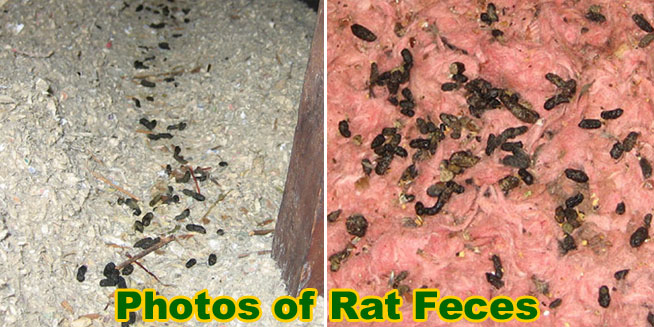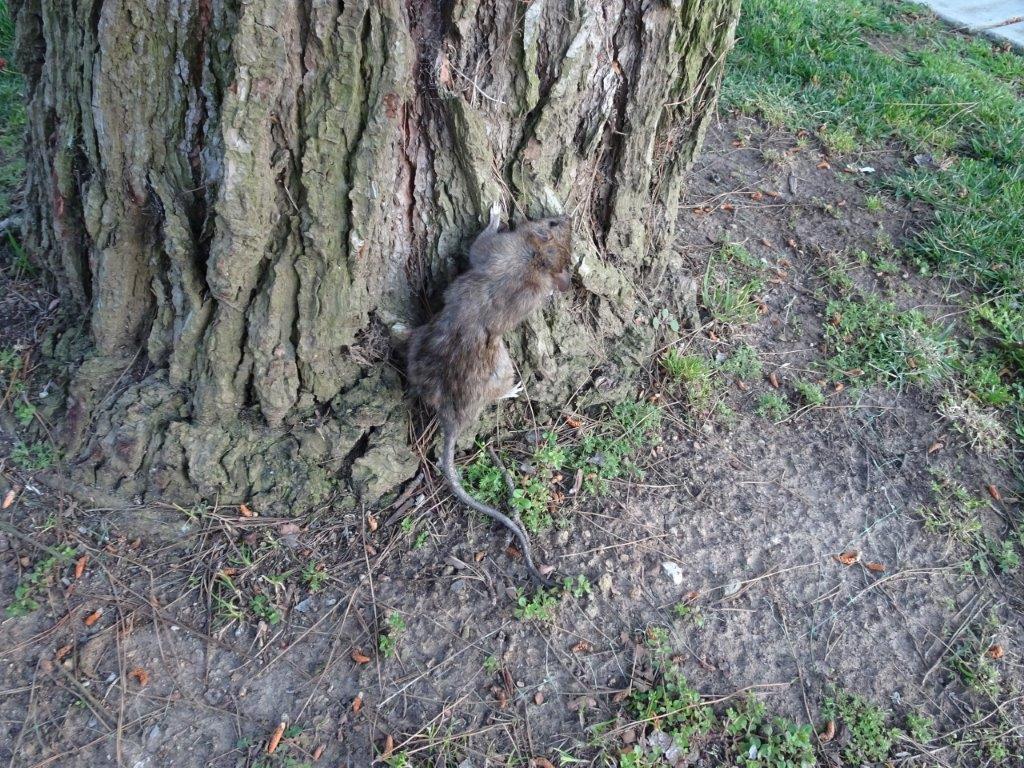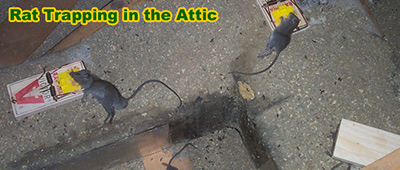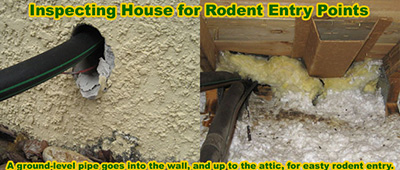Rats poop. Everyone does. Cool, but not everyone's poop is associated with dozens of diseases that humans can contract. Rats leave behind 10-30 poo pellets
per day, depending on how much they eat. They do go outside, but as they are sadly not housebroken, they also go potty in your attic, walls, pantry, wherever
they live.

How to identify rat feces: As you can see in the above photo, rats leave several skinny pellets scattered around, usually about 3/8 inch long and 1/8 inch in diameter, with rounded tips and maybe slightly bulging in the center. There is some size variance. Fresh ones are dark brown, but they get lighter with age. The feces tend to be wherever the rats move about, so sometimes you see trails of rat waste, such as in the photo above on the left.
Mouse feces tend to be quite a bit smaller, of course, with pointier tips and a little more bulging in the center. But all rodent droppings are small and dark brown.
DISEASES ASSOCIATED WITH RODENT FECES AND URINE
AS far as I know, over twenty different types of disease are associated with rat droppings. They include the Rickettsia virus, which can create a
condition similar to chicken pox. Hantavirus is another. Eosinophilic Meningitis is an infection of the brain, and caused by rat lung worm. The
droppings of rats can cause Leptospirosis or Salmonellosis.

After I remove rats from a building, I find it important to clean up afterward, to eliminate the rat latrine by vacuuming up all droppings, and fogging the attic with a special cleaner. I always wear protective gear.
Why do rat poop so much?
Rats eat a lot of food and therefore create a lot of waste. It's not just about nutrition; it has a lot to do with their constant chewing. Rats don't just chew on wood and cords and leave the pieces behind. A good amount of the substances they chew end up in the intestinal tract. The more they chew—and they chew constantly—the more they will eliminate droppings. Rat poop means much more to a rat than it does to the person who discovers the mess. Rats use their feces and urine to mark their territory. This scent trail allows the rat to move along designated pathways without hesitation. Under poor visual conditions, rats will use pheromones to guide them. Rat poop also holds the serious potential for disease. If you have discovered a large quantity of rat droppings, do not clean the mess until you can do so with proper safety equipment. Gloves are not the only tool you will need. Rodent diseases can become airborne, making a respirator mask a wise addition to your biohazard gear. People who come in contact with a high quantity of rodent waste may need to be hospitalized if they contract Salmonella or Hantavirus. It wasn't so long ago that the Plague was also a common disease in rats. There are some areas of The United States that still suffer from outbreaks of Plague.
What rodent is this poop from - rats? mice? squirrel?
All rodents poop frequently; the need to constantly chew facilitates that body function. You can usually determine the type of rodent by the size of the feces. Mice feces will be no larger than a grain of rice. If you are looking at pellet-sized stool,
chances are you have a rat or a squirrel on your hands. The difference between squirrel and rat poop can have a lot to do with shape and color. Because of their limited diets, squirrel droppings are usually lighter in color and have a wrinkled appearance.
Rats will eat almost anything, and their fecal matter is often dark and oblong in shape. Depending on the species of rat, the droppings ends may be rounded or pointed. If you are unskilled at determining the animal from waste material alone, look for clues
in other ways. Behavior is often a factor when determining what kind of animal is in your home. Rats are active at all times of the day. Squirrels tend to sleep at night (unless they are flying squirrels). Destruction is also a good indication of what kind
of animal is in your home. Rats will leave greasy marks around openings along with chew marks and urine puddles. Some squirrels will pick a communal bathroom and relieve themselves only in that location. If it doesn't look like rodent, it could be any type
of animal poop in the attic - but the way to remove and clean it remains roughly the same.
THE SAME APPLIES TO MOUSE FECES AND URINE
Although I wrote this site with rats in mind, such as the Roof Rat and
Norway Rat, the same principles apply to other rodents, such as the
house mouse. Mice behave very similarly to rats, they're just smaller. I'm not sure if there are as many diseases associated with mice poop.
Email me if you have any questions about mouse feces, how to remove poop from
mice, rodent urine and feces removal, and other queries.









